Have you ever struggled with diluting hydrogen peroxide correctly ❓ Or perhaps you’re new to using this powerful compound in your hydro or aero setup ? Fear not! The Hydrogen Peroxide Dilution Calculator is a grower’s best friend, ensuring you get the perfect dilution every time.
By using this calculator, you can easily determine the correct amount of hydrogen peroxide to add to your nutrient solution or reservoir. This calculation is based on your desired concentration and volume , eliminating any guesswork and saving you time ⏳ and resources.
So, are you ready to harness the power of hydrogen peroxide in your growing system? Keep reading to learn more about this amazing calculator and how it can simplify your growing process.
Hydrogen peroxide in hydroponics and aeroponics
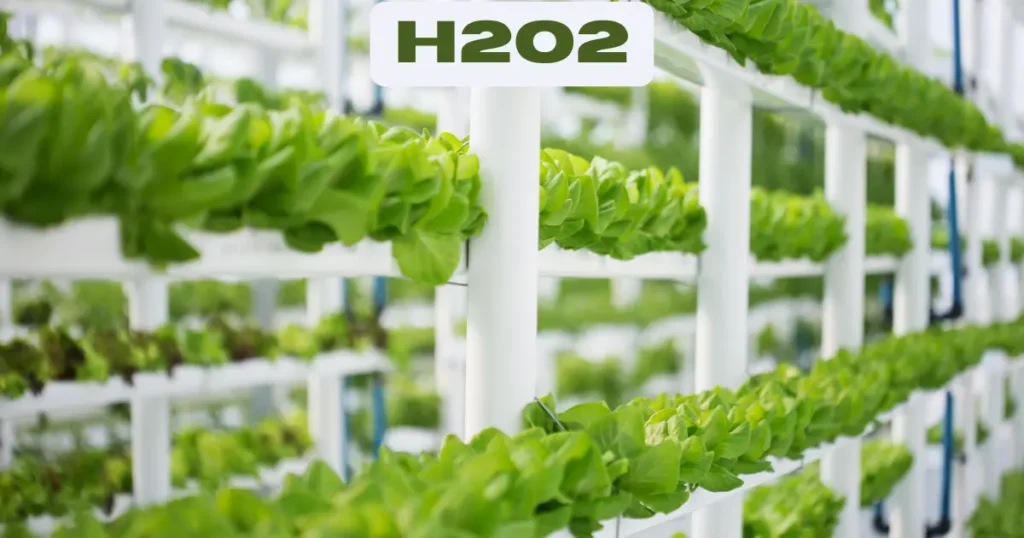
Hydrogen peroxide (H2O2) is a versatile and valuable tool for growers using hydroponic and aeroponic systems. This simple yet powerful compound can be utilized for a variety of purposes, from sterilization and disease control to promoting root health and oxygenation. However, it’s crucial to use hydrogen peroxide at the appropriate concentrations to avoid damaging your plants 🌱 .
Benefits of hydrogen peroxide:
In the world of hydroponics and aeroponics, hydrogen peroxide (H2O2) has proven to be an invaluable ally for growers seeking to maintain a healthy and thriving growing environment. This versatile compound offers a range of benefits, from its effectiveness against harmful pathogens to its ability to promote root health and oxygenation.
- One of the primary uses of hydrogen peroxide in hydroponic and aeroponic systems is its antimicrobial properties. H2O2 is highly effective against a wide range of bacteria, fungi, and algae that can potentially contaminate your nutrient solutions and harm your plants. By incorporating hydrogen peroxide into your routine maintenance, you can significantly reduce the risk of root rot, pythium, and other common issues caused by these unwanted microorganisms.
- In addition to its antimicrobial capabilities, hydrogen peroxide plays a crucial role in promoting healthy root development. When used at appropriate concentrations, it can help prevent the buildup of anaerobic conditions in the root zone, which can result in root suffocation and stunted growth. By providing an oxygenating boost to your nutrient solution, hydrogen peroxide encourages the formation of robust and vigorous root systems, enabling your plants to thrive and absorb nutrients more efficiently.
Risks of improper dilution:
But using the wrong concentration of hydrogen peroxide can harm your plants. Excessive hydrogen peroxide can damage roots and hinder growth, while insufficient amounts may not deliver the desired benefits. This is where the Hydrogen Peroxide Dilution Calculator becomes useful 👍 .
Using a hydrogen peroxide dilution calculator
By incorporating hydrogen peroxide and the Hydrogen Peroxide Dilution Calculator into your hydroponic or aeroponic routine, you will be well-equipped to maintain a clean, healthy, and highly oxygenated growing environment, setting the stage for bountiful and successful harvests.
What is a hydrogen peroxide dilution calculator ?
This convenient H2O2 dilution calculator eliminates the uncertainty of diluting hydrogen peroxide to the desired concentration. By entering the concentration of your stock solution and your target concentration, the peroxide dilution tool will calculate the exact amounts needed, guaranteeing that your nutrient solution is correctly balanced and optimized for your plants’ requirements.
There are several types of hydrogen peroxide dilution calculators available to meet your preferences and needs. If you prefer the convenience of online tools, there are several websites that offer user-friendly calculators accessible from any device with an internet connection. Alternatively, downloadable spreadsheets can be a great option for those who prefer working offline or integrating the calculator into their existing hydroponic management software.
If you’re constantly on the move, mobile apps can be a lifesaver. They allow you to conveniently access the Hydrogen Peroxide Dilution Calculator directly from your smartphone or tablet.
In the following section of this article, we will provide you with a Hydrogen Peroxide Dilution Calculator and explain how to effectively use it in your hydroponic or aeroponic setup.
How to use a hydrogen peroxide dilution calculator correctly ?
Using a Hydrogen peroxide dilution calculator is a simple process that can save you time and ensure accurate dilutions every time. Just follow these easy steps:
- Step 1: Input the starting concentration:
First, you need to determine the concentration of your stock hydrogen peroxide solution. This information is typically provided on the product label or packaging. For example, many household hydrogen peroxide solutions are sold at a concentration of 3%.
- Step 2 : Enter the desired final concentration:
Next, determine the target concentration required for your specific application. Different applications may require different concentrations. For example, a 0.5% solution is commonly recommended for root treatments, whereas a higher concentration of 1-2% may be used for sterilizing equipment or nutrient reservoirs.
- Step 3 : Specify the desired volume:
In this step, you will need to enter the total volume of the final solution that you want to prepare. This could be the capacity of your nutrient reservoir, the quantity required for a specific batch of plants, or any other desired volume.
- Step 4 : Calculate the dilution:
Once you have entered the necessary information, the H2O2 dilution calculator will perform its calculations and provide you with the precise amounts of hydrogen peroxide and water needed to achieve the desired dilution.
Here’s a worked example to illustrate the process:
Let’s say you have a 35% hydrogen peroxide stock solution, and you want to prepare a 3% solution for root zone treatment. Your nutrient reservoir holds 20 liters, so you will need a total of 20 liters of the diluted solution.
- Input:
- Starting concentration: 35%
- Desired final concentration: 3%
- Desired volume: 20 liters
- Result:
- The calculator will then determine that you need to mix 1.71 liters of the 35% hydrogen peroxide solution with 18.29 liters of water in order to achieve a 20-liter solution with a 3% concentration.
Now that you understand the process, you can put it into practice by using our H2O2 dilution calculator.
Hydrogen Peroxide Dilution Calculator
To achieve a % solution with a total volume of liters, you need to mix:
liters of % hydrogen peroxide
with
liters of water
Practical applications of hydrogen peroxide dilution
In hydroponic and aeroponic setups, the use of hydrogen peroxide dilutions is essential for maintaining a clean and healthy growing environment. Properly diluted solutions can efficiently combat harmful bacteria, fungi, and algae, thereby preventing the accumulation of pathogens. This ensures that the root zone conditions are optimal for plant growth.
Seed sterilization:
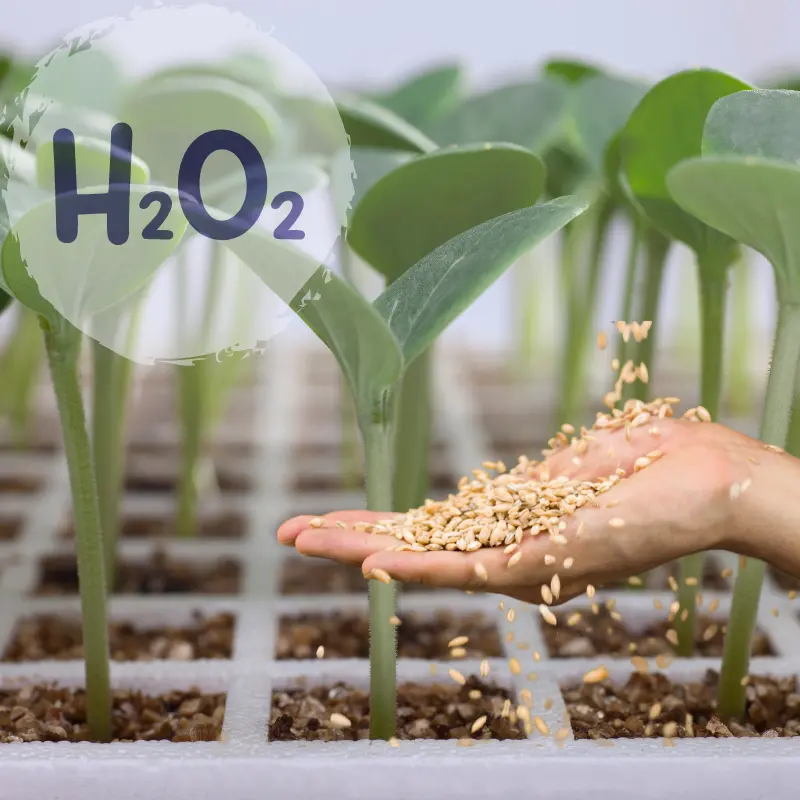
By treating your seeds with a diluted H2O2 solution, you can significantly decrease the chances of disease transmission and enhance healthy seed germination. Hydrogen peroxide, when properly diluted, can effectively kill a wide range of microorganisms, including bacteria, fungi, and viruses, without leaving behind any harmful chemical residues.
The recommended dilution ratio for seed sterilization typically ranges from 3% to 6% hydrogen peroxide solution. To sterilize your seeds, simply soak them in a diluted hydrogen peroxide solution for 10-15 minutes, making sure that all seeds are completely submerged. After soaking, rinse the seeds thoroughly with clean water to remove any remaining H2O2.
Root disease treatment:
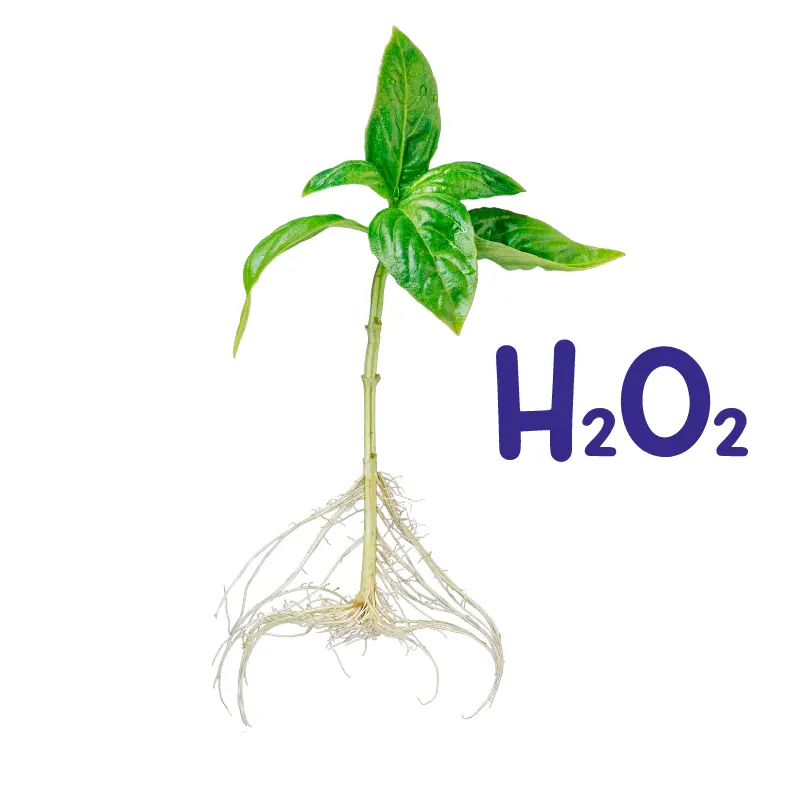
Hydrogen peroxide is an effective solution for eliminating various types of fungi, bacteria, and other pathogens that lead to root rot and fungal diseases. Additionally, it can serve as a preventive measure by creating an unfavorable environment for these harmful microorganisms.
To treat active root rot or fungal infections, use a 3% dilution of hydrogen peroxide. This concentration effectively fights against pathogens while still being safe for most plants when used appropriately.
Sarah shared her success story of using hydrogen peroxide to save her tomato crop from a devastating Pythium root rot outbreak.
“I noticed the telltale signs of wilting and discolored roots, and I knew I had to act fast,” she recalled. “I treated the affected plants with a 3% hydrogen peroxide solution, drenching the root zone and letting it work its magic. Within a week, the plants started to bounce back, and I was able to salvage most of my crop.”
System sterilization:
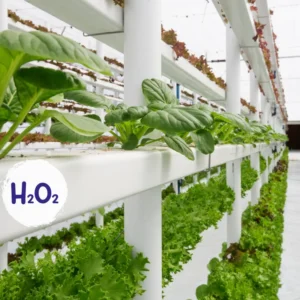
In the world of soilless cultivation, it is crucial to maintain a clean and sterile growing environment in order to achieve success. Hydroponic and aeroponic systems can gradually accumulate harmful buildup from sources such as algae, bacteria, and other contaminants, which can pose a threat to the health and productivity of your plants.
For effective system sanitation, it is generally recommended to use a dilution ratio of 3% to 5% hydrogen peroxide. This concentration is powerful enough to sanitize effectively but is also safe for use in hydroponic and aeroponic setups when handled correctly. To clean and sterilize your system:
- Start by draining any remaining nutrient solution or water.
- Next, thoroughly flush the entire system with the prepared hydrogen peroxide dilution. Make sure that all surfaces, tubing, and reservoirs are exposed to the solution.
- Allow the solution to remain in the system for at least an hour, or even overnight if you want a more thorough cleaning.
- After the recommended contact time, thoroughly flush the system with clean water to remove any residual hydrogen peroxide. This step is crucial to ensure that no harmful residues remain, which could potentially damage your next batch of plants.
One experienced aeroponic grower, Mike, shared his success story:
“I used to struggle with persistent algae buildup in my systems, but ever since I started incorporating a 5% hydrogen peroxide flush between grow cycles, my systems have been spotless. It’s made a massive difference in the overall health and vigor of my plants.”
Algae control:
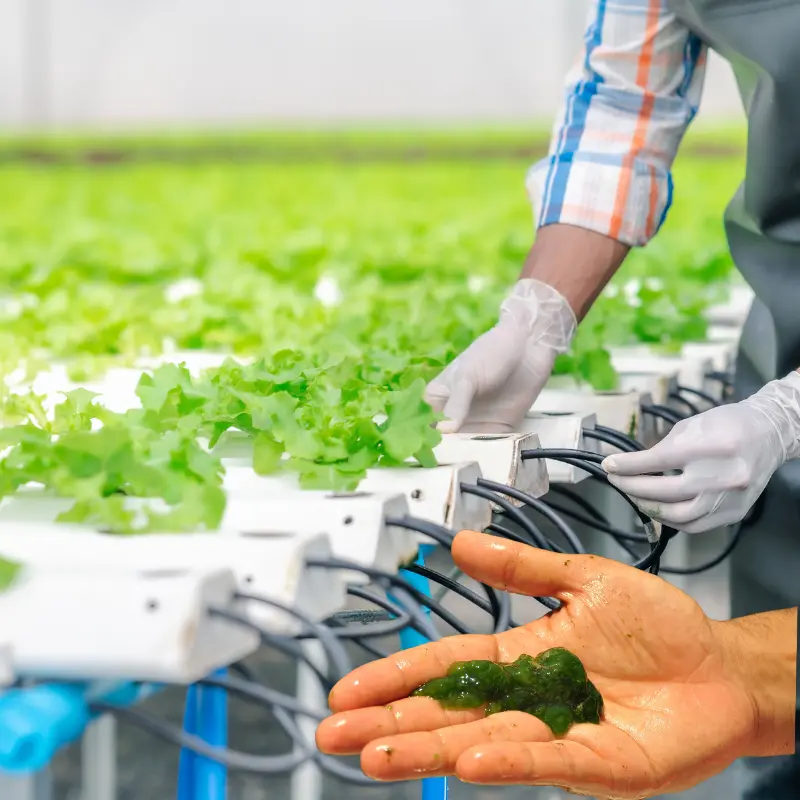
One of the biggest challenges that hydroponic growers constantly face is the problem of algae growth in their reservoirs and channels. Algae has the ability to rapidly multiply, which can lead to system blockages, nutrient depletion, and the potential development of harmful pathogens.
Hydrogen peroxide has powerful oxidizing properties, making it an effective algae growth inhibitor by disrupting their cellular processes. When used in the correct dilution ratios, it can control algae without harming your plants or introducing any harmful chemicals into your growing environment.
To control algae in hydroponic systems, it is generally recommended to use a dilution ratio of 1% to 3% hydrogen peroxide.
The application method and frequency will depend on the severity of algae growth and the specific setup of your hydroponic system. For reservoir-based systems, a common approach is to mix the diluted hydrogen peroxide directly into the nutrient solution and allow it to circulate throughout the system.
For channel-based systems, such as nutrient film technique (NFT) or deep water culture (DWC), a more focused approach might be required. In these setups, you can flush the channels or fill the reservoir with a diluted hydrogen peroxide solution. This will allow the solution to soak and effectively eliminate any existing algae. After an appropriate contact time (usually a few hours), make sure to thoroughly flush the system with clean water to remove any remaining solution.
Regular grower Emily shared her experience:
“I used to struggle with thick algae mats forming in my nutrient reservoir, but ever since I started adding a 2% hydrogen peroxide solution once a week, the algae growth has been kept in check. It’s been a game-changer for my system’s cleanliness and plant health.”
Remember, when working with hydrogen peroxide, it is essential to follow proper safety precautions and dilution guidelines, as well as use a hydrogen peroxide dilution calculator. Always handle the solution with care and avoid direct contact with the skin or eyes.
Tips for safe and effective use hydrogen peroxide dilution
While hydrogen peroxide dilutions offer a powerful and eco-friendly solution for various applications, it is crucial to handle and use them with proper precautions. Hydrogen peroxide is a strong oxidizing agent, and mishandling can result in skin irritation, eye damage, or other potential hazards.
To ensure your safety and the effective use of this versatile solution, follow these essential tips:
- Wear protective gloves :
- Hydrogen peroxide can cause skin irritation and dryness with prolonged exposure. Always wear protective gloves, preferably made of nitrile or rubber, when handling and applying hydrogen peroxide dilutions. This simple precaution will prevent direct contact with your skin, minimizing the risk of irritation or chemical burns.
- Protect your eyes 👁️ :
- Hydrogen peroxide can be extremely harmful to the eyes, leading to severe irritation, burning, or even impaired vision if it comes in contact. Therefore, it is absolutely necessary to wear suitable eye protection, such as safety goggles or a face shield, when handling diluted hydrogen peroxide. It’s crucial to note that even a small splash can result in serious consequences. Therefore, always prioritize eye safety.
- Ensure proper ventilation :
- Hydrogen peroxide can release fumes, especially when diluted or mixed with other solutions. It is important to work in a well-ventilated area or ensure sufficient ventilation to prevent the accumulation of potentially harmful vapors. By taking this simple precaution, you can minimize respiratory irritation and maintain a safe working environment.
- Follow recommended dilution ratios :
- This is where the hydrogen peroxide dilution calculator comes into play, offering a simple and convenient tool to determine the correct dilution ratios for your specific needs.
Conclusion
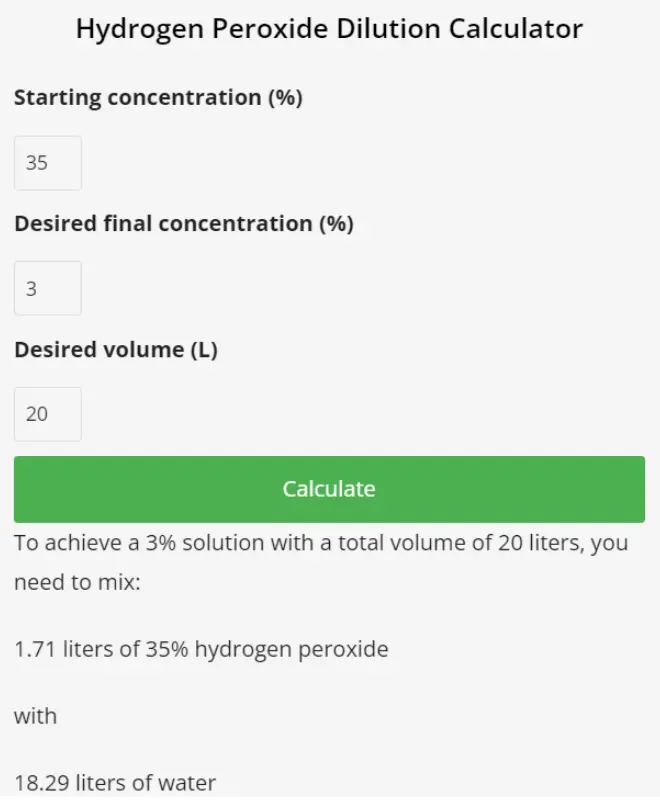
Achieving the correct dilutions of hydrogen peroxide is essential for ensuring effectiveness and safety.
No more laborious calculations or the risk of making mistakes. This calculator does the work for you, guaranteeing consistent and reliable results. By offering a simple and user-friendly interface, this tool eliminates the need for guesswork when preparing accurate dilutions. With just a few inputs, you can easily determine the exact volumes of hydrogen peroxide and water required to achieve your desired concentration.
As you begin your hydroponics or aeroponics journey, make use of the hydrogen peroxide dilution calculator to harness its power. It allows you to experiment with various dilutions and determine the ideal concentration for your specific requirements. Whether you want to combat algae growth in your reservoir, address root rot issues, or maintain an immaculate growing environment, this calculator will guide you towards achieving your goals.
Don’t hesitate to share your experiences and successes with the dilution calculator within our growing community. By sharing your insights and tips, you can help fellow cultivators get the most out of this versatile tool, fostering a collective effort towards sustainable and efficient cultivation practices. So, why not give the hydrogen peroxide dilution calculator a try today?
Why use hydrogen peroxide in hydroponic systems?
Hydrogen peroxide is a powerful oxidizer that can efficiently maintain optimal conditions in hydroponic systems. It achieves this by eliminating harmful pathogens, breaking down nutrient buildup, and enhancing oxygen levels in the water.
How do I use a hydrogen peroxide dilution calculator?
To use a hydrogen peroxide dilution calculator, you typically need to input the desired concentration of hydrogen peroxide as a percentage, along with the volume of the hydroponic solution in your system. The calculator will then calculate the required amount of hydrogen peroxide to add in order to achieve the desired concentration.
Is hydrogen peroxide safe for hydroponic seeds?
When used properly and at appropriate concentrations, hydrogen peroxide is generally safe for hydroponic seeds. However, to avoid any adverse effects, it is crucial to follow recommended guidelines for dilution and application. Always handle hydrogen peroxide with care and store it properly out of the reach of children and pets.
Can I use hydrogen peroxide for disinfecting hydroponic equipment and tools?
Yes, hydrogen peroxide can be used to disinfect hydroponic equipment and tools in order to prevent the spread of pathogens. To do so, prepare a diluted solution (e.g., 3% hydrogen peroxide) and use it to thoroughly clean surfaces, containers, and other equipment. Afterwards, rinse the items with clean water to remove any residue.
What are the potential risks associated with using hydrogen peroxide in hydroponic systems?
Overusing or improperly using hydrogen peroxide can result in plant stress, nutrient deficiencies, or harm to beneficial microorganisms. To minimize these risks, it is important to always adhere to using a hydrogen peroxide dilution calculator.

About the Author
As a woman expert in sustainable, environmental, and natural farming methods.
I write about houseplant care sharing tips and tricks i’ve learned over the years to help keep your plants happy and healthy.



